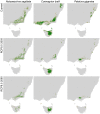Continental-scale assessment of risk to the Australian odonata from climate change
- PMID: 24551197
- PMCID: PMC3923880
- DOI: 10.1371/journal.pone.0088958
Continental-scale assessment of risk to the Australian odonata from climate change
Abstract
Climate change is expected to have substantial impacts on the composition of freshwater communities, and many species are threatened by the loss of climatically suitable habitat. In this study we identify Australian Odonata (dragonflies and damselflies) vulnerable to the effects of climate change on the basis of exposure, sensitivity and pressure to disperse in the future. We used an ensemble of species distribution models to predict the distribution of 270 (85%) species of Australian Odonata, continent-wide at the subcatchment scale, and for both current and future climates using two emissions scenarios each for 2055 and 2085. Exposure was scored according to the departure of temperature, precipitation and hydrology from current conditions. Sensitivity accounted for change in the area and suitability of projected climatic habitat, and pressure to disperse combined measurements of average habitat shifts and the loss experienced with lower dispersal rates. Streams and rivers important to future conservation efforts were identified based on the sensitivity-weighted sum of habitat suitability for the most vulnerable species. The overall extent of suitable habitat declined for 56-69% of the species modelled by 2085 depending on emissions scenario. The proportion of species at risk across all components (exposure, sensitivity, pressure to disperse) varied between 7 and 17% from 2055 to 2085 and a further 3-17% of species were also projected to be at high risk due to declines that did not require range shifts. If dispersal to Tasmania was limited, many south-eastern species are at significantly increased risk. Conservation efforts will need to focus on creating and preserving freshwater refugia as part of a broader conservation strategy that improves connectivity and promotes adaptive range shifts. The significant predicted shifts in suitable habitat could potentially exceed the dispersal capacity of Odonata and highlights the challenge faced by other freshwater species.
Conflict of interest statement
Figures





Similar articles
-
Climate change risks, extinction debt, and conservation implications for a threatened freshwater fish: Carmine shiner (Notropis percobromus).Sci Total Environ. 2017 Nov 15;598:1-11. doi: 10.1016/j.scitotenv.2017.03.228. Epub 2017 Apr 20. Sci Total Environ. 2017. PMID: 28433817
-
Evolutionary refugia and ecological refuges: key concepts for conserving Australian arid zone freshwater biodiversity under climate change.Glob Chang Biol. 2013 Jul;19(7):1970-84. doi: 10.1111/gcb.12203. Epub 2013 Apr 18. Glob Chang Biol. 2013. PMID: 23526791 Free PMC article. Review.
-
Differentiating the effects of climate and land use change on European biodiversity: A scenario analysis.Ambio. 2017 Apr;46(3):277-290. doi: 10.1007/s13280-016-0840-3. Epub 2016 Nov 1. Ambio. 2017. PMID: 27804097 Free PMC article.
-
Current and future effects of global change on a hotspot's freshwater diversity.Sci Total Environ. 2018 Sep 1;635:750-760. doi: 10.1016/j.scitotenv.2018.04.056. Epub 2018 Apr 24. Sci Total Environ. 2018. PMID: 29680765
-
Facilitating climate-change-induced range shifts across continental land-use barriers.Conserv Biol. 2015 Dec;29(6):1586-95. doi: 10.1111/cobi.12556. Epub 2015 Jul 20. Conserv Biol. 2015. PMID: 26193759 Review.
Cited by
-
Climate model variability leads to uncertain predictions of the future abundance of stream macroinvertebrates.Sci Rep. 2020 Feb 13;10(1):2520. doi: 10.1038/s41598-020-59107-y. Sci Rep. 2020. PMID: 32054891 Free PMC article.
-
Species distribution models predict genetic isolation of Hetaerina vulnerata Hagen in Selys, 1853 (Odonata, Calopterygidae).Ecol Evol. 2024 Aug 6;14(8):e70107. doi: 10.1002/ece3.70107. eCollection 2024 Aug. Ecol Evol. 2024. PMID: 39108563 Free PMC article.
-
Influence of adaptive capacity on the outcome of climate change vulnerability assessment.Sci Rep. 2017 Oct 11;7(1):12979. doi: 10.1038/s41598-017-13245-y. Sci Rep. 2017. PMID: 29021590 Free PMC article.
-
Can fisheries bioenergetics modelling refine spatially explicit assessments of climate change vulnerability?Conserv Physiol. 2022 Jul 2;10(1):coac035. doi: 10.1093/conphys/coac035. eCollection 2022. Conserv Physiol. 2022. PMID: 35795018 Free PMC article.
-
Metacommunity patterns of Amazonian Odonata: the role of environmental gradients and major rivers.PeerJ. 2019 May 6;7:e6472. doi: 10.7717/peerj.6472. eCollection 2019. PeerJ. 2019. PMID: 31119064 Free PMC article.
References
-
- Vörösmarty CJ, McIntyre PB, Gessner MO, Dudgeon D, Prusevich A, et al. (2010) Global threats to human water security and river biodiversity. Nature 467: 555–561. - PubMed
-
- Durance I, Ormerod SJ (2007) Climate change effects on upland stream macroinvertebrates over a 25-year period. Global Change Biology 13: 942–957.
-
- Ricciardi A, Rasmussen JB (1999) Extinction rates of North American freshwater fauna. Conservation Biology 13: 1220–1222.
-
- Flenner IDA, Richter O, Suhling F (2009) Rising temperature and development in dragonfly populations at different latitudes. Freshwater Biology 55: 397–410.
-
- Floury M, Usseglio-Polatera P, Ferreol M, Delattre C, Souchon Y (2012) Global climate change in large European rivers: long-term effects on macroinvertebrate communities and potential local confounding factors. Global Change Biology 19: 1085–1099. - PubMed
Publication types
MeSH terms
LinkOut - more resources
Full Text Sources
Other Literature Sources

